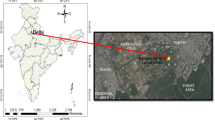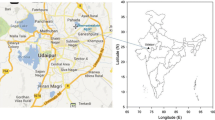Abstract
This study focused on O3 variations and the titration effects of NOx during nighttime at urban, industrial, sub-urban and background sites. Nighttime O3 concentration variations and the presence of high particles with an aerodynamic diameter of less than 10 μm (PM10) were examined because haze disturbs the photochemical reactions of O3. Hourly data on O3, NO2, NO and PM10 concentrations provided by the Air Quality Division of the Department of Environment were divided into two groups of daytime and nighttime and analysed. The maximum O3 concentrations during daytime were generally observed during noon. At nighttime, the concentration of O3 decreased, indicating that destruction activities occurred mainly via titration. The retention of O3 during daytime caused the nighttime O3 during haze events to be higher than that during normal days. Apparent fluctuations in nighttime O3 concentrations were observed in the urban site (20 ± 13 ppb) during haze events. The NO2/NO ratio in the urban site during haze was higher than that on normal days; amongst the sites, the urban one had the highest value (6.6). Results indicated that during haze, the reactions between NO and O3 were enhanced at nighttime, leading to low nighttime NO concentrations. The low nighttime NO concentrations led to low nighttime NO titration rates, which enabled O3 to persist in ambient air. Nighttime O3 was not completely absent due to anthropogenic sources. This condition accelerated NO titration to NO2, thus promoting O3 production even during haze.




Similar content being viewed by others
References
Ahamad F, Latif MT, Tang R, Juneng L, Dominick D, Juahir H (2014) Variation of surface ozone exceedance around Klang Valley, Malaysia. Atmos Res 139:116–127. https://doi.org/10.1016/j.atmosres.2014.01.003
Ahmed M, Guo X, Zhao XM (2016) Determination and analysis of trace metals and surfactant in air particulate matter during biomass burning haze episode in Malaysia. Atmos Environ 141:219–229
Ainsworth EA, Yendrek CR, Sitch S, Collins WJ, Emberson LD (2012) The effects of tropospheric ozone on net primary productivity and implications for climate change. Annu Rev Plant Biol 63:637–661
Alghamdi M, Khoder M, Harrison RM, Hyvärinen AP, Hussein T, Al-Jeelani H, Almehmadi F (2014) Temporal variations of O3 and NOx in the urban background atmosphere of the coastal city Jeddah, Saudi Arabia. Atmos Environ 94:205–214. https://doi.org/10.1016/j.atmosenv.2014.03.029
An J, Zou J, Wang J, Lin X, Zhu B (2015) Differences in ozone photochemical characteristics between the megacity Nanjing and its suburban surroundings, Yangtze River Delta, China. Environ Sci Poll Res 22(24):19607–19617
Ashfold M, Latif M, Samah A, Mead M, Harris N (2017) Influence of northeast monsoon cold surges on air quality in Southeast Asia. Atmos Environ 166:498–509
Atkinson R (2000) Atmospheric chemistry of VOCs and NOx. Atmos Environ 34(12):2063–2101
Awang NR, Ramli NA (2017) Preliminary study of ground-level ozone nighttime removal process in an urban area. J Trop Resour Sustain Sci 5:83–88
Awang NR, Ramli NA (2018) Ground-level ozone in Malaysia: fluctuational and transformational characteristics. School of Civil Engineering. Universiti Sains Malaysia. ISBN: 978-967-0167-21-3.
Awang NR, Ramli NA, Yahaya AS, Elbayoumi M (2015) Multivariate methods to ground-level ozone during the daytime, nighttime, and critical conversion time in urban areas. Atmos Pollut Res 6(5):726–734. https://doi.org/10.5094/APR.2015.081
Awang NR, Elbayoumi M, Ramli NA, Yahaya AS (2016) Diurnal variations of ground-level ozone in three port cities in Malaysia. Air Qual Atmos Health 9(1):25–39
Awang NR, Ramli NA, Shith S, Zainordin NS, Manogaran H (2018) Transformational characteristics of ground-level ozone during high particulate events in the urban area of Malaysia. Air Qual Atmos Health 11(6):715–727
Banan N, Latif MT, Juneng L, Ahamad F (2013) Characteristics of surface ozone concentrations at stations with different backgrounds in the Malaysian Peninsula. Aerosol Air Qual Res 13(3):1090–1106. https://doi.org/10.4209/aaqr.2012.09.0259
Brimblecombe P (2009) Transformation in understanding the health impacts of air pollutants in the 20th century. In: Paper Presented at the EPJ Web of Conferences.
Brown SS, Stutz J (2012) Nighttime radical observations and chemistry. Chem Soc Rev 41(19):6405–6447. https://doi.org/10.1039/C2CS35181A
Clapp LJ, Jenkin ME (2001) Analysis of the relationship between ambient levels of O3, NO2 and NO as a function of NOx in the UK. Atmos Environ 35:6391–6405. https://doi.org/10.1016/S1352-2310(01)00378-8
Dey S, Sibanda P, Gupta S, Chakraborty A (2017) Occurrences of high nocturnal surface ozone at a tropical urban area. Inter J Environ Eco Eng 11(2):97–105. https://doi.org/10.5281/zenodo.1339752
DOE (2013) Department of environment, Malaysia. Malaysia environmental quality report 2013. In: M. O. S. Department of Environment, Technology and the Environment, Malaysia
Dominick D, Latif MT, Juneng L, Khan MF, Amil N, Mead MI, Nadzir MSM, Moi PS, Samah AA, Ashfold MJ, Sturges WT, Harris NRP, Robinson AD, Pyle JA (2015) Characterisation of particle mass and number concentration on the east coast of the Malaysian Peninsula during the Northeast monsoon. Atmos Environ 117:187–199
Dufour G, Fremenko M, Orphan J, Flaud J (2010) IASI observations of seasonal and day-to-day variations of tropospheric ozone over three highly populated areas of China: Beijing, Shanghai, and Hong Kong. Atmos Chem Phys 10:3787–3801. https://doi.org/10.5194/acp-10-3787-2010
Ghazali NA, Ramli NA, Yahaya AS, Md Yusof NFF, Sansuddin N, Al Madhoun W (2010) Transformation of nitrogen dioxide into ozone and prediction of ozone concentrations using multiple linear regression techniques. Environ Monit Assess 165(1):475–489. https://doi.org/10.1007/s10661-009-0960-3
Ghosh D, Lal S, Sarkar U (2013) High nocturnal ozone levels at a surface site in Kolkata, India: trade-off between meteorology and specific nocturnal chemistry. Urban Clim 5:82–103. https://doi.org/10.1016/j.uclim.2013.07.002
Gu JX, Bai ZP, Liu AX, Wu LP, Xie YY, Li WF, Dong HY, Zhang X (2010) Characterization of atmospheric organic carbon and element carbon of PM2.5 and PM10 at Tianjin, China. Aerosol Air Qual Res 10:167–176. https://doi.org/10.4209/aaqr.2009.12.0080
Han S, Bian H, Feng Y, Liu A, Li X, Zeng F, Zhang X (2011) Analysis of the relationship between O3, NO and NO2 in Tianjin China. Aerosol Air Qual Res 11:128–139. https://doi.org/10.4209/aaqr.2010.07.0055
Hassan IA, Basahi JM, Ismail IM, Habeebullah TM (2013) Spatial distribution and temporal variation in ambient ozone and its associated NOx in the atmosphere of Jeddah City, Saudi Arabia. Aerosol Air Qual Res 13:1712–1722
He J, Wang Y, Hao J, Shen L, Wang L (2012) Variations of surface O3 in August at a rural site near Shanghai: influences from the West Pacific subtropical high and anthropogenic emissions. Environ Sci Poll Res 19(9):4016–4029
IDA (2010) International Dark-sky Association: City light pollution affects air pollution. Available on http://banbillboardblight.org/wp-content/uploads/2010/12/Light-Pollution-Effects-Air-Pollution.pdf. 15th December 2010, Access on April 2018, 2010
Khalil MAK, Butenhoff CL, Harrison RM (2018) Ozone balances in urban Saudi Arabia. Climate and Atmospheric Science 1(1):27. https://doi.org/10.1038/s41612-018-0034-8
Khan M, Latif M, Saw W, Amil N, Nadzir M, Sahani M, Tahir N, Chung J (2016) Fine particulate matter in the tropical environment: monsoonal effects, source apportionment, and health risk assessment. Atmos Chem Phys 16:597–617
Kulkarni PS, Bortoli D, Silva AM (2013) Nocturnal surface ozone enhancement and trend over urban and suburban sites in Portugal. Atmos Environ 71:251–259. https://doi.org/10.1016/j.atmosenv.2013.01.051
Kumar A, Singh D, Singh BP, Singh M, Anandam K, Kumar K, Jain VK (2015) Spatial and temporal variability of surface ozone and nitrogen oxides in urban and rural ambient air of Delhi-NCR, India. Air Qual Atmos Health 8(4):391–399
Kusumaningtyas SDA, Aldrian E (2016) Impact of the June 2013 Riau province Sumatera smoke haze event on regional air pollution. Environ Res Lett 11(7):075007
Latif MT, Huey LS, Juneng L (2012) Variations of surface ozone concentration across the Klang Valley, Malaysia. Atmos Environ 61:434–445
Latif MT, Dominick D, Ahamad F, Khan MF, Juneng L, Hamzah FM, Nadzir MSM (2014) Long term assessment of air quality from a background station on the Malaysian Peninsula. Sci Total Environ 482:336–348. https://doi.org/10.1016/j.scitotenv.2014.02.132.
Li G, Bei N, Tie X, Molina LT (2011) Aerosols effects on the photochemistry in Mexico City during the MCMA-2006/MILAGRO campaign. Atmos Chem Phys 11:5169–5182. https://doi.org/10.5194/acp-11-5169-2011.
Li G, Bei N, Cao J, Wu J, Long X, Feng T, Dai W, Liu S, Zhang Q, Tie X (2017) Wide-spread and persistent ozone pollution in eastern China during the non-winter season of 2015: observations and source attributions. Atmos Chem Phys 17:2759–2774. https://doi.org/10.5194/acp-17-2759-2017.
McNaught AD, Wilkinson A (1997) IUPAC. In: Compendium of chemical terminology, 2nd edn. (the BGold book^). Blackwell Scientific Publications, Oxford.
Mohammed NI, Ramli NA, Yahya AS (2013) Ozone phytotoxicity evaluation and prediction of crops production in tropical regions. Atmos Environ 68:343–349. https://doi.org/10.1016/j.atmosenv.2012.09.010
Péré JC, Bessagnet B, Pont V, Mallet M, Minvielle F (2015) Influence of the aerosol solar extinction on photochemistry during the 2010 Russian wildfires episode. Atmos Chem Phys 15(19):10983–10998. https://doi.org/10.5194/acp-15-10983-2015
Pugliese SC, Murphy JG, Geddes JA, Wang JM (2014) The impacts of precursor reduction and meteorology on ground-level ozone in the greater Toronto area. Atmos Chem Phys 14:8197–8207
Quan J, Tie X, Zhang Q, Liu Q, Li X, Gao Y, Zhao D (2014) Characteristics of heavy aerosol pollution during the 2012–2013 winter in Beijing, China. Atmos Environ 88:83–89
Rahman HA (2013) Haze phenomenon in Malaysia: domestic or transboundary factor? In: Paper Presented at the 3rd International Journal Conference on Chemical Engineering and its Applications (ICCEA’13), Phuket (Thailand), 597–599
Ran L, Zhao C, Xu W, Han M, Lu X, Han S, Lin W, Xu X, Gao W, Yu Q, Geng F, Ma N, Deng Z, Chen J (2012) Ozone production in summer in the megacities of Tianjin and Shanghai, China: a comparative study. Atmos Chem Phys 12:7531–7542. https://doi.org/10.5194/acp-12-7531-2012
Reddy PJ, Pfister GG (2016) Meteorological factors contributing to the interannual variability of mid-summer surface ozone in Colorado, Utah, and other western U.S. states. J Geophys Res Atmos 121:2434–2456. https://doi.org/10.1002/2015JD023840
Saxena P, Ghosh C (2011) Variation in the concentration of ground-level ozone at selected sites in Delhi. Inter J Environ Sci 1(7):1899–1911
Stutz J, Wong KW, Lawrence L, Ziemba L, Flynn JH, Rappenglück B, Lefer B (2010) Nocturnal NO3 radical chemistry in Houston, TX. Atmos Environ 44(33):4099–4106. https://doi.org/10.1016/j.atmosenv.2009.03.004
Toh YY, Lim SF, von Glasow R (2013) The influence of meteorological factors and biomass burning on surface ozone concentrations at Tanah Rata, Malaysia. Atmos Environ 70:435–446. https://doi.org/10.1016/j.atmosenv.2013.01.018
Velasco E, Rastan S (2015) Air quality in Singapore during the 2013 smoke-haze episode over the Strait of Malacca: lessons learned. Sustain Cities Society 17:122–131
Wang T, Xue L, Brimblecombe P, Lam YF, Li L, Zhang L (2017) Ozone pollution in China: a review of concentrations, meteorological influences, chemical precursors, and effects. Sci Total Environ 575:1582–1596. https://doi.org/10.1016/j.scitotenv.2016.10.081
Young PJ, Archibald AT, Bowman KW, Lamarque JF, Naik V, Stevenson DS, Tilmes S, Voulgarakis A, Wild O, Bergmann D, Cameron-Smith P, Cionni I, Collins WJ, Dalsøren SB, Doherty RM, Eyring V, Faluvegi G, Horowitz LW, Josse B, Lee YH, MacKenzie IA, Nagashima T, Plummer DA, Righi M, Rumbold ST, Skeie RB, Shindell DT, Strode SA, Sudo K, Szopa S, Zeng G (2013) Pre-industrial to end 21st-century projections of tropospheric ozone from the atmospheric chemistry and climate model intercomparison project (ACCMIP). Atmos Chem Phys 13:2063–2090. https://doi.org/10.5194/acp-13-2063-2013
Yusoff MF, Latif MT, Juneng L, Khan MF, Ahamad F, Chung JX, Mohtar AAA (2019) Spatio-temporal assessment of nocturnal surface ozone in Malaysia. Atmos Environ 207:105–116
Zhao S, Yu Y, Yin D, Qin D, He J, Dong L (2018) Spatial patterns and temporal variations of six criteria air pollutants during 2015 to 2017 in the city clusters of Sichuan Basin, China. Sci Total Environ 624:540–557. https://doi.org/10.1016/j.scitotenv.2017.12.172
Acknowledgements
The authors would like to express their gratitude to Universiti Sains Malaysia, Universiti Malaysia Kelantan and the Department of Environment, Malaysia.
Funding
This study was funded by the Research University Individual Grant (1001/PAWAM/814278) and the Fundamental Research Grant Scheme (R/FRGS/10800/01525A/003/2018/00554).
Author information
Authors and Affiliations
Corresponding author
Additional information
Publisher’s note
Springer Nature remains neutral with regard to jurisdictional claims in published maps and institutional affiliations.
Rights and permissions
About this article
Cite this article
Shith, S., Awang, N.R., Latif, M.T. et al. Fluctuations in nighttime ground-level ozone concentrations during haze events in Malaysia. Air Qual Atmos Health 14, 19–26 (2021). https://doi.org/10.1007/s11869-020-00908-5
Received:
Accepted:
Published:
Issue Date:
DOI: https://doi.org/10.1007/s11869-020-00908-5




